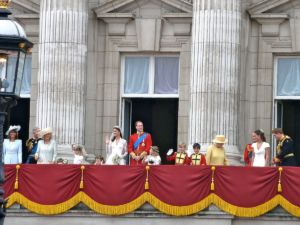 Buckingham Palace group following the wedding of Prince William, the new Duke of Cambridge, and Catherine Middleton, April 2011. Courtesy of Wikimedia Commons
Buckingham Palace group following the wedding of Prince William, the new Duke of Cambridge, and Catherine Middleton, April 2011. Courtesy of Wikimedia Commons
I recently came across an article on the shift that will occur when the present Prince of Wales succeeds his mother. This article seemed to me to muddy the fairly straightforward waters, so here is my attempt to describe the coming changes in nomenclature.
Let’s begin by supposing that the Prince of Wales will be King Charles III and the Duchess of Cornwall will be Queen Camilla. I have seen references to Prince Charles as King George VII, one of his other forenames, and of course the present Duchess of Cornwall has sometimes been accorded the future title of Princess Consort. Centuries of evolving usage nevertheless suggest that the Prince of Wales and Duchess of Cornwall will be King and Queen.
The title of Prince of Wales, bestowed on the present Prince in 1958, will merge with the crown...
What else? The present Duke of Cambridge will succeed his father as Duke of Cornwall, and for some period of time will be styled (with his wife) Duke and Duchess of Cornwall and Cambridge. The title of Prince of Wales, bestowed on the present Prince in 1958, will merge with the crown; it will need to be conferred again and, since the Duke of [Cornwall and] Cambridge is an adult, will probably be granted around the time of the coronation.
The children of the current Duke and Duchess of Cambridge will become Prince George, Princess Charlotte, and Prince Louis of Cornwall and Cambridge until their father is created Prince of Wales, after which they will be Prince or Princess George, Charlotte, or Louis of Wales.
The treatment of the Duke and Duchess of Sussex, as son and daughter-in-law of the monarch, will not change much, although — like the other children of the present Queen — Prince Harry will be accorded the prefix The, as in HRH The Prince Henry (or Harry), Duke of Sussex. The Sussex children, currently entitled to courtesy titles as if the offspring of a non-royal duke — so Earl of Dumbarton and Lady Lilibet Mountbatten-Windsor — would then become HRH Prince Archie and HRH Princess Lilibet of Sussex. Why? because they have moved up an important step, to become grandchildren of the monarch.
Why? because they have moved up an important step, to become grandchildren of the monarch.
For now, Prince Charles is also the 2nd Duke of Edinburgh, and will remain so until the title merges back into the crown. A fresh creation, of a new Duke of Edinburgh, might then be made for Prince Edward. The dukedom of York will in time become extinct, as Prince Andrew does not have a male heir … and the title’s creation did not allow for a daughter to inherit. The earldom of Wessex will pass to Viscount Severn, like his sister Lady Louise Mountbatten-Windsor entitled to the style of a grandchild of the monarch. The Princess Royal long since declined titles for her children.
In future years, the dukedoms of Gloucester and Kent will become non-royal titles, as will Sussex (in Archie Mountbatten-Windsor’s son's generation), so, during the twenty-first century the British royal family will slim down to the families of Princes William and Harry (and, perhaps, Prince Edward).
Share this:
About Scott C. Steward
Scott C. Steward has been NEHGS’ Editor-in-Chief since 2013. He is the author, co-author, or editor of genealogies of the Ayer, Le Roy, Lowell, Saltonstall, Thorndike, and Winthrop families. His articles have appeared in The New England Historical and Genealogical Register, NEXUS, New England Ancestors, American Ancestors, and The Pennsylvania Genealogical Magazine, and he has written book reviews for the Register, The New York Genealogical and Biographical Record, and the National Genealogical Society Quarterly.View all posts by Scott C. Steward →